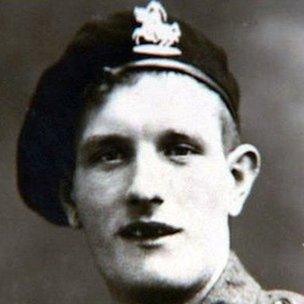Moira Anderson murder: A 57-year search for the truth
- Published

Moira Anderson disappeared in Coatbridge on 23 February 1957
It was a bitter, snowy Saturday evening when Moira Anderson left her grandmother's house in Coatbridge to buy some butter.
The date was 23 February 1957, an era now dim in the memory.
Harold MacMillan had just become prime minister following the Suez crisis. The Reverend Martin Luther King of Montgomery, Alabama, graced the cover of that week's Time magazine for the first time.
In Coatbridge that weekend, the weather was bad, with a blizzard blowing in, but as she stepped out into the street, Moira was wrapped-up well, in her navy school coat and a knitted hat.
She was a slight, pretty girl with fair hair and blue eyes, something of a tomboy, who enjoyed swimming and playing marbles.
The Co-op in Laird Street was a short distance from Moira's gran's house in Muiryhall Street, but there is no evidence that Moira ever arrived at the shop.
As the hours and then the days passed the people of Coatbridge, horrified by the mystery of the missing girl, searched and searched but not a trace was ever found.
Moira's family never saw her again and, for many years it seemed likely that no-one would ever know what had happened to her.
Townsfolk criticised the efforts of the police and, in the absence of hard evidence, suspicion fell, unfairly, on Moira's family.
In fact officers did have one important lead - witnesses had seen Moira boarding a local Baxter's bus. But detectives appear to have failed to follow it up properly.
Had they done so, they would have discovered that the bus driver was Alexander Gartshore, who was on bail at the time facing charges of raping his children's babysitter.
Family secret
Gartshore, a freemason in a lodge where many local policemen were also said to be members, had long been suspected of being a "flasher" in local parks.
On 23 January 1957 he had been charged with "having carnal knowledge of a minor and other offences of a sexual nature."
In February Moira went missing.
In April, Gartshore was convicted and sentenced to 18 months in prison.

Alexander Gartshore was jailed for 18 months in 1957 for abusing a young girl
But it was not until his estranged daughter, Sandra Brown, discovered this terrible family secret that the search for the truth really began. Even then it took many more years to find it.
Recalling events in her book "Where There is Evil", Mrs Brown describes how, in 1992, she confronted Gartshore about his failings as a father.
To her astonishment, she writes, he told her that his own father "wouldn't forgive me for Moira Anderson".
"Grandpa was always convinced I'd done it," he told his daughter. "He said to me tae tell the polis where I'd put the wee lassie.
"...I was the driver of the bus the day she went missing. I told Grandpa I didn't even know her, but she got on my bus, in all the snow. I was the last tae speak tae her. I was the last person tae see her..."
Horrified by the conversation, and suspecting that she now knew the killer, Mrs Brown began a long campaign to bring her own father to justice.
When he was interviewed by police in 1992, Gartshore claimed that Moira had boarded his bus to buy a surprise birthday card for her mother at Woolworth's.
The revelation was intriguing. It was indeed Maisie Anderson's 40th birthday the day after her daughter disappeared but how would Gartshore have known that if he had not spoken to Moira?
Detectives felt it gave credibility to the case against their suspect, placing Moira on the bus and hinting that she knew the driver well, despite his denials.
New witnesses
Nonetheless, they concluded that there was not enough evidence to charge Gartshore, and he died in 2006.
Last year, the case was given new impetus as police and prosecutors from Scotland's cold case unit exhumed a grave in Old Monkland Cemetery where a friend of Gartshore had been buried around the time that Moira disappeared.

Sandra Brown wrote a book in which she outlined her suspicions that her father had killed Moira
The theory was that Gartshore had used the funeral to shift Moira from a ditch and hide her where no-one would think of looking - in a graveyard.
Moira's remains were not in the plot but the case gained widespread media coverage and two new witnesses came forward.
According to the Crown Office, Scotland's prosecuting authority, both witnesses had credible reasons for not having done so before.
The first witness recalled how, as a little girl in Coatbridge, Gartshore had exposed himself to her and Moira Anderson in a local park in the summer of 1956 and had called Moira by name.
Even more importantly, the second witness stated that late in the afternoon on 23 February 1957, near the Carnbroe bus terminus, he had seen a man "dragging a young girl by the arms".
The witness said the girl looked like Moira Anderson. He also identified the man as Gartshore.
With other circumstantial evidence, these witness accounts would have been enough, say the Crown, for a murder trial.
Apart from the obvious - why? - and the practical - how and where? - many questions remain.
Was anyone else involved in the killing?
Was it incompetence or even corruption which stymied the original police investigation?
And, of course, where is Moira's body?
But at least one question which has haunted Coatbridge for more than half a century, does appear to have been answered: it seems that Alexander Gartshore murdered Moira Anderson.
- Published31 January 2014